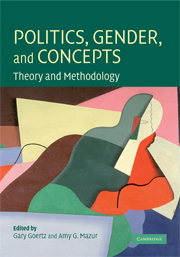Book contents
- Frontmatter
- Contents
- List of figures
- List of tables
- Notes on contributors
- Acknowledgments
- 1 Introduction
- 2 Mapping gender and politics concepts: ten guidelines
- Part I Gendering Concepts
- 3 Gendering democracy
- 4 Gendering representation
- 5 Gendering the welfare state
- 6 Gendering governance
- 7 Gendering development
- Part II Gender-Specific Concepts
- Appendix: A website for additional gender and politics concepts
- References
- Index
7 - Gendering development
Published online by Cambridge University Press: 06 July 2010
- Frontmatter
- Contents
- List of figures
- List of tables
- Notes on contributors
- Acknowledgments
- 1 Introduction
- 2 Mapping gender and politics concepts: ten guidelines
- Part I Gendering Concepts
- 3 Gendering democracy
- 4 Gendering representation
- 5 Gendering the welfare state
- 6 Gendering governance
- 7 Gendering development
- Part II Gender-Specific Concepts
- Appendix: A website for additional gender and politics concepts
- References
- Index
Summary
What happens when one conceptualizes development with a gender lens? I try to answer this question, focusing on the editors' conceptual guidelines, in order that readers may acquire insights on and pathways toward researchable questions about meaningful issues. In so doing, I hope to sustain readers' interests on a reading/writing journey that addresses people's lives, deaths, and well-being around the world. The journey offers enormous potential for substantive research, action, policies, and outcomes. To my mind, guidelines do not trump substance, but attentiveness to the guidelines should produce better substantive research and outcomes. This chapter addresses the intersection of comparative politics and international relations (IR), bringing in North–South dimensions and thereby adding enormous complexities to this collection. The chapter embraces almost two hundred nations, thousands of cultures, and the institutions within and between them – both governmental and nongovernmental organizations (NGOs). People in transnational institutions and in governments create, implement, resist, and respond to public policies for “development” in “developing countries.” The word “development” is highly politicized, traveling (Traveling Guideline) awkwardly in multiple directions, bottom-up, top-down, and sideways from researchers to international organizations (IOs), to governments and multiple agencies therein, to NGOs, and to the people who supposedly benefit from development interventions (but are sometimes burdened instead). For most of history and in the early post-World War II era, analysts had not examined development with a gender lens.
- Type
- Chapter
- Information
- Politics, Gender, and ConceptsTheory and Methodology, pp. 136 - 156Publisher: Cambridge University PressPrint publication year: 2008
- 3
- Cited by

